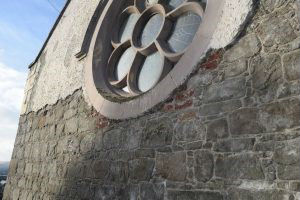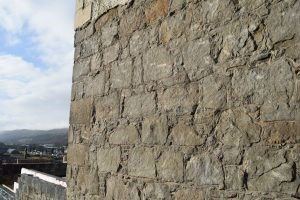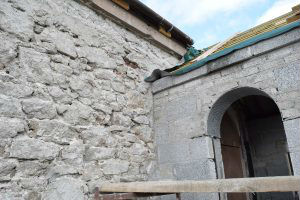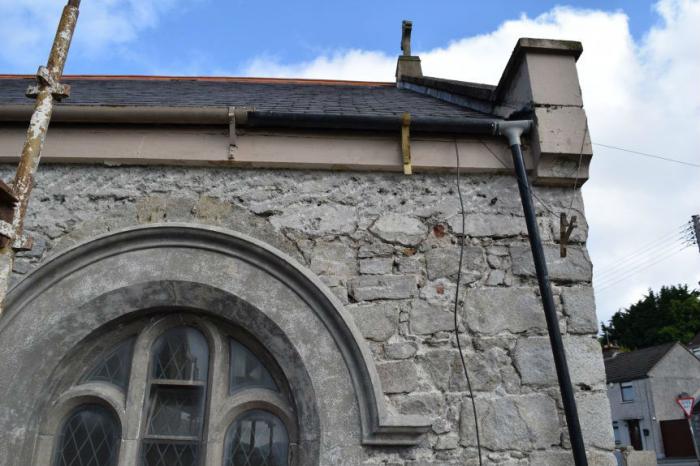- Home
- News
St Mary's Renovations; A History Lesson.

written by Paul McCormack
St Mary’s Church the ‘Old Chapel’ on Chapel Street has been Newry’s Rock of Ages since 1789. Standing proudly at the head of Chapel Street, watching over the graveyard below, the Church is currently undergoing a major restoration and the work to the façade has revealed a tapestry of how Newry society was over 200 years ago. In the last quarter of the 18th century, Ireland was emerging from the shadow of the Penal Laws, the fires of rebellion were burning across Europe, political uncertainty was rife and, ably led by Bishop Matthew Lennon, the parishioners of Newry looking towards a bright future, began to lay the foundations of St Mary’s to replace an old Mass-house.
The main walls in the church are built of ‘field stone’ and ‘rubble’ with only the East Wall (facing Chapel Street) made from rough square ‘hammer dressed’ granite and with smaller stones between to ensure break joints for strength. The wall closest to the road being the ‘best dressed’ as would have been the fashion of the time
Without doubt, every town and city in Ireland has fine examples of buildings or monuments made from granite. As one of the most distinctive of building stones, granite has long been prized for its strength and durability as well as its attractive appearance especially when it was ‘dressed’ granite.
You only have to look at the Cathedral of St Patrick & St Colman constructed in 1829 only 40 years after St Mary’s to see how changed times in Ireland brought a new belief and a confidence to build a new cathedral complete with cut, dressed granite – an imposing structure.
However, with the plaster render removed from the walls of St Mary’s, it has revealed a raw beauty of rough stone, uncoursed rubble supported by the prayers, offerings and intentions of worshipers for over 227 years. A structure which in many ways is even more appealing and interesting than other buildings made from expensive cut stone. The round choir window on the east wall evidences how changes have been made to the chapel over the years. The windows of the original chapel, which would have been smaller and rectangular in shape, have undergone renovations over the years, changing the face of St Mary’s. These changes are clearly evidenced with ‘expensive’ red brick being used in these renovations. Red brick wasn’t an option when St Marys’ was originally constructed.
The hymn Rock of Ages written in 1763 by Augustus Montague-Toplady has the first line ‘Rock of Ages, cleft for me’ which could have been written with St Mary’s in mind. St Mary’s, our rock, our cleft, has provided shelter and protection for many years and generations gone and when the current renovations are complete will continue to do so for many years to come. A church built by people of vision and now being renovated by the descendants of these people with the same shared vision affording parishioners with space to worship God sheltered, cared for and protected by our Rock of Ages.
With the old plaster removed and the external walls stripped bare, several interesting facts have been uncovered. The southern facing window in the choir gallery, long thought to be a modern addition has the smaller arch of a previous narrower window above it. The old window seems to be about half as wide as the present but there are no indications of how long it was. The old plaster still remains on half of the east facing round window – again a late addition as betrayed by the use of red brick. When this old plaster is removed what hidden gems and from over 200 years ago will it uncover?
The roof of the church has a one metre plinth of concrete visible above the final course of stone. This shows that the roof was ‘raised’ in previous years – was this to allow for the addition of the present vaulted ceiling or was it to allow for the addition of the 3 galleries?
Some of the most interesting changes to St Mary’s are where the new sections and access points are being added. In modern materials of block and metal these new works contrast with the old stone structure and provide great examples of where the new meets the old. Why not stop a while on Chapel St/St Mary’s Hill and marvel at the centuries old building and how the craftsmen of today, following in the steps of their forefathers, are bringing the Old Lady of Chapel Street back to her full glory?
We, as custodians of the church, today are honoured to carry on the hopes, aspirations and wishes of our forefathers and ensure that the ‘Old Chapel’ stands for many centuries to come.
The children of St Clare's Abbey have had an exciting year and have been part of history!
In the future they can look back and marvel at the changes they have been part of in 2016. The move to a new state of the art building on Courtenay Hill and the part they played in fundraising to secure the future of St Mary's Church, "The Old Chapel"
Our thanks to Paul Mc Cormack for writing news articles for the parish and allowing us to share them on our school website.
St Clare's Abbey Primary School, Nursery, ECPD, 12 Courtenay Hill, Newry, BT34 2EA | T: 028 3026 2175
WEBSITE BY: SCHOOLWEBDESIGN.NET | Login







